|
|
Research Progress on Alumina Aerogel Composites for High-temperature Thermal Insulation
PENG Fei, JIANG Yonggang, FENG Jian, CAI Huafei, FENG Junzong, LI Liangjun
2021 Vol. 36 (7): 673–684
 Abstract
Abstract(
1524 )
 HTML
HTML(
102)
 PDF
PDF(15163KB)(
2661
)
As a nano-porous material with high porosity, low density, high specific surface area, excellent heat-resistance, and low thermal conductivity, the alumina aerogel shows broad application prospect in high-temperature thermal insulating areas such as the thermal protective system for space vehicles and the thermal insulation for industrial kilns. However, pristine alumina aerogels can’t be directly used because of their relatively poor thermal resistance above 1000 ℃, mechanical strengths and high-temperature thermal insulating performance. They need to be improved by introducing reinforcements and opacifiers (namely the alumina aerogel composite). This paper summarizes the latest research progress of synthesis of heat-resistant alumina aerogels, and preparation and properties of alumina aerogel composites. Researchers improved the thermal stability of alumina aerogels by modifications such as in-situ doping, deposition, organic chains or carbon coatings. The introduction of whiskers, particles, porous skeletons or fibers into alumina aerogels contributes to considerable improvement of mechanical performance. The cooperation of fibers and opacifiers help to increase the inhibition of infrared radiation and lower the high-temperature thermal conductivity of alumina aerogels. The future of alumina aerogel composites is also proposed: a) finely tailoring the bulk density, micro structures, and introducing proper foreign elements and opacifiers, are supposed to further optimize the thermal stability of alumina aerogels and thermal insulating performance of their composites; b) deeper attention should also be paid on the evolution of structure and properties of composites at elevated temperatures, and on the interaction between alumina aerogel and reinforcement. As a novel thermal insulation, alumina aerogel composites are expected to take their advantages and be widely applied in the future.
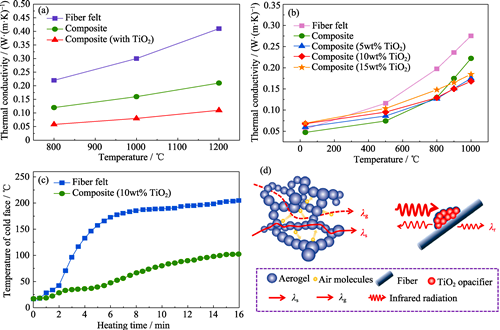
|
|
|
Research Progress on the Preparation and Characterization of Ultra Refractory TaxHf1-xC Solid Solution Ceramics
XIAO Peng, ZHU Yulin, WANG Song, YU Yiping, LI Hao
2021 Vol. 36 (7): 685–694
 Abstract
Abstract(
827 )
 HTML
HTML(
32)
 PDF
PDF(2624KB)(
993
)
TaxHf1-xC(0<x<1) solid solution ceramics, a series of solid solutions of tantalum carbide (TaC) and hafnium carbide (HfC) over the whole range of composition, have been considered as promising candidates for many important applications which can tolerate temperature above 3000 K due to their high melting points (> 4000 K), high hardness (~ 30 GPa), low coefficient of thermal expansion, excellent oxidation resistance, and excellent ablation resistance. Over the past decades, some extreme conditions required for aerospace industry have greatly promoted the development of TaxHf1-xC materials, and dozens of literatures were published in this area. In this paper, the research progress of TaxHf1-xC solid solution ceramics was introduced in terms of powder synthesis techniques, densification methods and mechanism, mechanical properties at room temperature, thermophysical properties, oxidation and ablation resistance. Advantages and disadvantages of three common techniques (solid solution between metal carbides, carbonization reaction of metals, and carbothermal reduction of metal oxides) for synthesizing TaxHf1-xC powder as well as the difficulties in densification of TaxHf1-xC solid solution ceramics were analyzed. Influence of sintering process on microstructure and mechanical properties at room temperature of TaxHf1-xC solid solution ceramics was discussed briefly. The hardness, elastic modulus, KIC, melting point, thermal conductivity, coefficient of thermal expansion, oxidation and ablation behavior of TaxHf1-xC solid solution ceramics with different Ta/Hf ratios were summarized. It revealed that TaxHf1-xC solid solution ceramics will obtain a good performance on both mechanical properties and oxidation resistance when Ta/Hf was approximate 1. Furthermore, the remaining challenges and future outlook of TaxHf1-xC solid solution ceramics were also addressed.
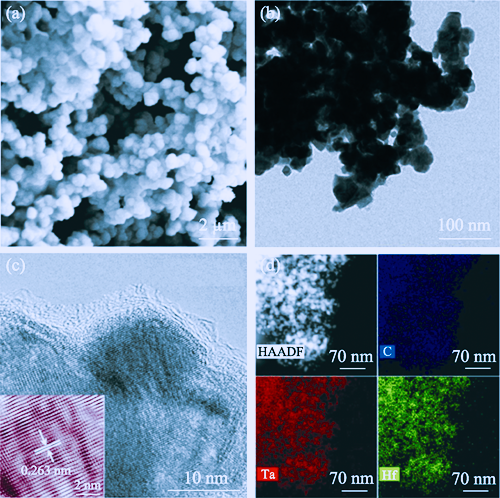
|
|
|
Research Progress of Biomimetic Self-assembly of Nanomaterials in Morphology and Performance Control
LI Huaxin, CHEN Junyong, XIAO Zhou, YUE Xian, YU Xianbo, XIANG Junhui
2021 Vol. 36 (7): 695–710
 Abstract
Abstract(
1022 )
 HTML
HTML(
72)
 PDF
PDF(27572KB)(
1623
)
Nano materials exhibit many excellent properties compared with macro scale materials due to their special properties at nanoscale. They exhibit good application prospects in various fields such as mechanics, acoustics, optics, magnetism, electricity, thermology and so on. In this fascinating field, biomimetic self-assembly technology of nano materials has become one of the main methods to prepare nano materials, which simulates the life activities in vivo and makes the nano materials spontaneously form stable structures based on the noncovalent bond interaction. The biomimetic self-assembly technology is an important technology in the “bottom-up” method, which is expected to replace the traditional “top-down” processing technology, and realize the construction of specific structure and function devices on the nanoscale by single atom or molecule. Moreover, although the bionic self-assembly technology is mainly chemical process, it also has physical process, and combines advantages of “bionics” and has characteristics of directional construction of nano materials, which is a hot research means of many interdisciplinary. This paper reviews different biomimetic self-assembly synthesis strategies for nano materials in morphology and performance control, including phase selective self-assembly of shielding effect, bionic self-assembly of biphase interface synergy effect, integrated fabrication of functional devices with field induced localization effect, photoinduced self-assembly and phase separation self-assembly driven by hydroxyl hydrogen bond. The characteristics of biomimetic self-assembled nano materials are summarized. This paper also introduced the application of self-assembly technology in sensors, surface Raman scattering, biomedical and other fields. In addition, the prospects for the development of biomimetic self-assembly technology of nanomaterials are prospected.
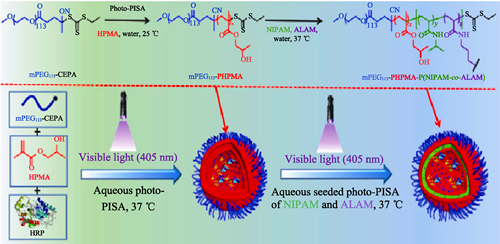
|
|
|
Influence of N/S Co-doping on Electrochemical Property of Brucite Template Carbon Nanotubes
LIU Fangfang, CHUAN Xiuyun, YANG Yang, LI Aijun
2021 Vol. 36 (7): 711–717
 Abstract
Abstract(
677 )
 HTML
HTML(
27)
 PDF
PDF(4469KB)(
788
)
N/S doped carbon nanotubes were prepared with natural mineral fibrous brucite as template, sucrose as carbon source, and thiourea as nitrogen and sulfur source. Experimental results indicate that the doped carbon nanotubes inherit the one-dimensional columnar structure of the fibrous brucite template. In addition, it presents a hollow tubular structure, which increases the specific surface area and pore volume of the template carbon. In 6 mol·L-1 KOH electrolyte, the electrochemical performance significantly improves after doping. CNT-N/S presents a high specific capacity of 172.0 F·g-1 at current density of 1 A·g-1, higher than those of CNT (62.2 F·g-1) and CNT-N (97.0 F·g-1). The capacitance of the N/S doped carbon nanotubes remains 89% after 1000 charge-discharge cycles. Furthermore, the assembled symmetrical supercapacitor also shows good capacitance performance.
|
|
|
Microwave-assisted Synthesis and Co, Al Co-modification of Ni-rich LiNi0.8Mn0.2O2 Materials for Li-ion Battery Electrode
FU Yukun, ZENG Min, RAO Xianfa, ZHONG Shengwen, ZHANG Huijuan, YAO Wenli
2021 Vol. 36 (7): 718–724
 Abstract
Abstract(
870 )
 HTML
HTML(
73)
 PDF
PDF(12530KB)(
1066
)
Due to high specific capacity and cost performance, high-nickel cathode materials have received much attention. However, its further application is hindered by poor stability and safety performance during cycling. In this work, Ni-rich LiNi0.8Mn0.2O2 materials were prepared through microwave-assisted co-precipitation followed by high-temperature solid-phase method, which can be further modified by doping different proportions of Co and Al. As a result, LiNi0.8Mn0.1Co0.08Al0.02O2 (NMCA-2) exhibits the best electrochemical performance, whose capacity retention rate reaches 91.39% after 100 cycles at 1C in the voltage range between 2.75 and 4.35 V, and still owns a specific discharge capacity of 160.03 mAh∙g-1 at 5C. Its excellent cyclic retention rate can be attributed to the restrained irreversibility of H2→H3 phase transition during cycling with Co and Al doping, and the lower reaction polarization which contributed to the decline of charge transfer resistance, resulting in good cycle and rate performance of the material. Furthermore, high thermal stability of NMCA-2 improves the safety of the material.
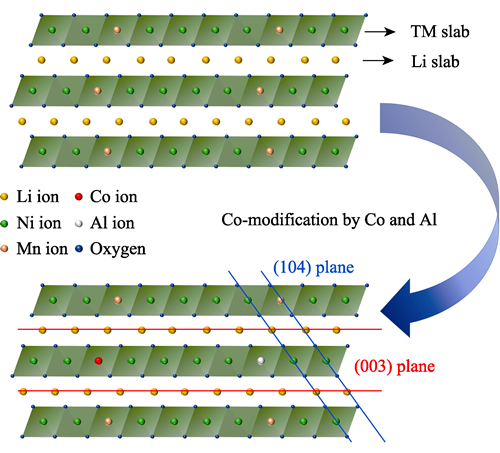
|
|
|
Preparation and Catalytic Properties of Graphene-Bismuth Ferrite Nanocrystal Nanocomposite
LI Tie, LI Yue, WANG Yingyi, ZHANG Ting
2021 Vol. 36 (7): 725–732
 Abstract
Abstract(
748 )
 HTML
HTML(
47)
 PDF
PDF(3448KB)(
820
)
BiFeO3 (BFO) is a novel recyclable photocatalyst which benefits from its appropriate theoretical band gap and room temperature ferromagnetism, yet the relatively high recombination rate of photogenerated electron-hole pairs and low quantum yield limit its practical catalytic performance. Here, a composite material of reduced graphene oxide and BiFeO3 nanocrystals (RGO-BFO) was successfully prepared via a hydrothermal self-assembly process with about 10wt% RGO loaded 85wt% BFO nanocrystalline (~10 nm). Specific surface area of the composite is about 5 times of that of pure BFO particles. Furthermore, this nanocomposite demonstrates the enhanced ultraviolet absorption behavior as well as its intrinsic visible light absorption, with an energy gap (Eg) of 2.0 eV, which is about 10% lower than BFO particles (2.3 eV). As a result, a significantly higher catalytic efficiency of nearly 100% of the RGO-BFO was obtained as compared to the 25% value of BFO after a 40-min process of adsorption and photodegradation for methylene blue. The improved performances may be attributed to the additional photogenerated electron-hole pairs and lower recombination ratio, which can be proved by the result of photoelectric response. As an intrinsically ferromagnetic material, it could be easily recycled from the solvent system, and its repetitive catalytic efficiency maintained 89.1% after 6 cycles, showing a good catalytic stability.
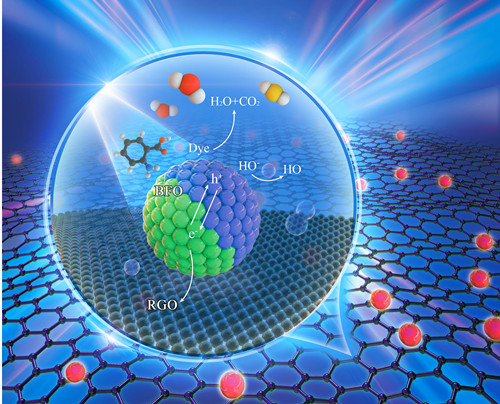
|
|
|
Pre-crack and Fracture Toughness Evaluation of Ceramic Thin Plates
MA Delong, BAO Yiwang, WAN Detian, QIU Yan, ZHENG Dezhi, FU Shuai
2021 Vol. 36 (7): 733–737
 Abstract
Abstract(
445 )
 HTML
HTML(
7)
 PDF
PDF(1378KB)(
694
)
Controllable length of pre-crack and in-situ observation are two major difficulties in the research of fracture resistance of ceramic materials. In this study, a method of strain-induced cracking was proposed, in which the plate was bonded to a brass beam to form a composite. The bending deformation of brass beam derived the tension deformation in the tension zone of ceramic thin plate to induce the controllable crack. Four-point bending test was conducted under a tool microscope to perform in-situ observation of crack propagation. The initial crack length was controlled by adjusting the width of the tensile zone of the ceramic plate. After the crack initiation, loading continued to make the crack length meet the requirements of fracture toughness test for ceramics. Compared with standard test of fracture toughness of block materials, the above method is simple and reliable. The strain-induced method to pre-crack has high success rate, the position of crack initiation and the length of pre-crack are controllable and easy to operate. It can be widely applied to fracture toughness evaluation and crack propagation resistance analysis of ultra-thin glass and other ultra-thin brittle materials.
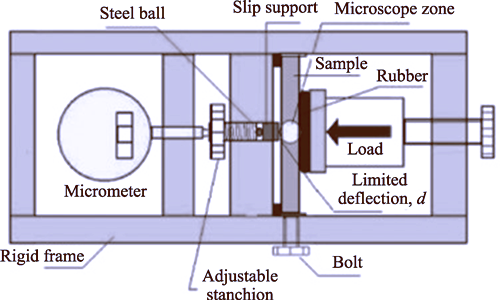
|
|
|
Mo Doped Cuprorivaite: Preparation, Antibacterial and Cytocompatibility
WANG Endian, CHANG Jiang
2021 Vol. 36 (7): 738–744
 Abstract
Abstract(
586 )
 HTML
HTML(
15)
 PDF
PDF(5170KB)(
718
)
Copper-containing biomaterials have excellent inhibitory effect on bacteria growth by releasing copper ions at high concentration, which may have cytotoxicity at the same time. Although low concentration of copper ions has good cytocompatibility, the antibacterial activity is unsatisfactory. Therefore, it is of great significance to develop copper- containing biomaterials, which have excellent antibacterial property and good cytocompatibility. In this study, on considering the antagonistic effect between copper and molybdenum, molybdenum doped cuprorivaite (Mo-Cup) was synthesized by Sol-Gel method and its antibacterial properties and cell compatibility were evaluated by bacterial plate experiment and cell activity assay. The results showed that copper ions with high concentration (above 8.87 μg∙mL -1) released from Mo-Cup had a good inhibitory effect on Staphylococcus aureus. In addition, because the antagonistic effect between copper and molybdenum ions released from Mo-Cup can reduce the cytotoxicity of high concentration of copper ions, the survival rate of umbilical vein endothelial cells (HUVECs) was as high as 90% in the extracts of Mo-Cup at a high Cu ion concentration (9.65 μg∙mL -1). Therefore, molybdenum doping can be considered as an effective approach to reduce the cytotoxicity of copper-containing biomaterials for the development of low-toxic antibacterial biomaterials.
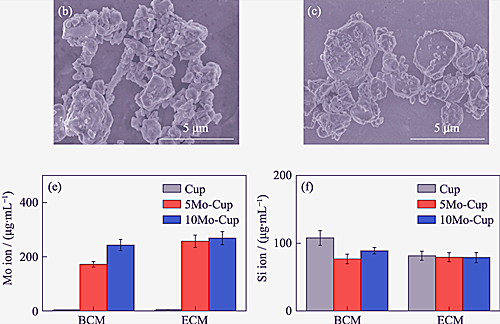
|
|
|
Different Simulated Body Fluid on Mineralization of Borosilicate Bioactive Glass-based Bone Cement
LIN Ziyang, CHANG Yuchen, WU Zhangfan, BAO Rong, LIN Wenqing, WANG Deping
2021 Vol. 36 (7): 745–752
 Abstract
Abstract(
448 )
 HTML
HTML(
21)
 PDF
PDF(6237KB)(
706
)
Borosilicate bioactive glass-based (BBG) bone cement has important application prospects in the treatment of osteoporotic fractures, bone tumors, bone trauma, osteomyelitis, and other diseases due to its excellent bioactivity and biodegradability. To further understand the factors affecting its mineralization ability after implantation into human body, three kinds of amino acid were added into the conventional simulated body fluids (SBF) solution. Furthermore, to get whitlockite (WH) and hydroxyapatite (HA) simultaneously during the mineralization process, the environmental temperature, pH and Mg2+ concentration of SBF were adjusted. The mineralized products of BBG bone cement after being immersed in different SBF solutions were characterized. It is found that the effects of amino acids on mineralization products are quite different, of which aspartic acid and lysine affect the aspect ratio of the mineral, but glycine does not affect the morphology of the mineral. After the borosilicate bioactive glass tablet being immersed in an acidic (pH 3.5) SBF solution with a high Mg2+ content at 70 ℃ for a certain period, HA/WH complex mineral can be obtained.
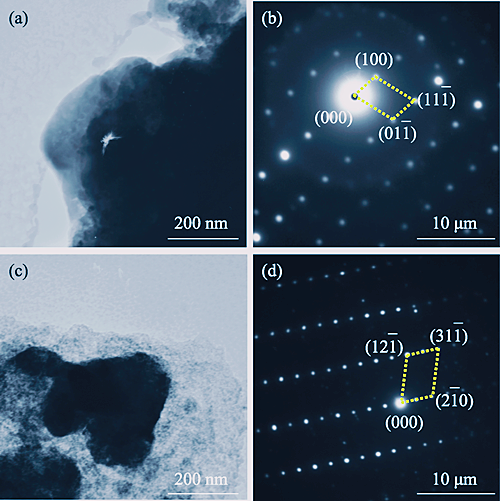
|
|
|
Mineralization Activity of Li2Ca2Si2O7 Bioceramics
XU Hongyi, ZHAI Dong, CAO Wanting, CHEN Zhenhua, QIAN Wenhao, CHEN Lei
2021 Vol. 36 (7): 753–760
 Abstract
Abstract(
329 )
 HTML
HTML(
14)
 PDF
PDF(10919KB)(
823
)
How to effectively treat periodontitis and achieve regeneration of damaged periodontal tissue has always been a challenging problem in the treatment of periodontal diseases, and mineralization is one of the key factors in the normal periodontal development and function. The aim of this study was to investigate the effects of Li2Ca2Si2O7 bioceramics on proliferation and mineralization of human periodontal ligament fibroblasts (HPLFs) and possibility of its application in periodontal tissue regeneration. Li2Ca2Si2O7 ceramic powder was synthesized by Sol-Gel method. It was found that Li2Ca2Si2O7 powder had good ability of hydroxyapatite mineralization by immersing in simulated body fluid. The in vitro biological results showed that Li2Ca2Si2O7 powder extract could significantly promote proliferation of HPLFs in the concentration range of 3.125~25 mg/mL, and at low concentration (6.25 mg/mL), could significantly induce mineralization of HPLFs cells (p<0.05). All these experimental results reveal that the new Li2Ca2Si2O7 powder can promote proliferation and mineralization of HPLFs, and it may be a promising bioactive material for periodontal tissue regeneration.
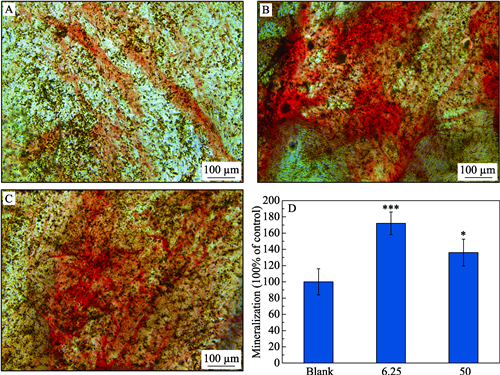
|
|
|
Growth of High-quality Yb3+-doped Y3Al5O12 Single Crystal Fiber by Laser Heated Pedestal Growth Method
DAI Yun, ZHANG Zhonghan, SU Liangbi, LI Jin, LONG Yong, DING Yuchong, WU Anhua
2021 Vol. 36 (7): 761–765
 Abstract
Abstract(
408 )
 HTML
HTML(
9)
 PDF
PDF(1679KB)(
876
)
Single-crystal fiber (SCF) is a fiber-shaped monocrystalline material, which is an important tendency for the development of low-dimensional functional crystals. Combining the excellent optical properties of bulk crystals and the high-efficient thermal dissipation as well as the high beam quality of optical fibers, SCFs are believed to solve the bottlenecks of conventional laser fibers such as unfavorable non-linear effects and poor thermal conductivities, can thus achieve higher laser peak powers and pulse energy. Here, we describe the results of synthesis and characterization of two Yb3+-doped Y3Al5O12 (Yb:YAG) SCFs (Ф0.2 mm×710 mm), which were grown by a self- developed laser-heated pedestal growth (LHPG) apparatus. The prepared SCFs possess a length-to-diameter ratio greater than 3500, a diameter fluctuation less than 5%, and show high flexibility for bending. The analysis of X-ray rocking curve indicates that the crystallinity of the grown SCF is improved compared with that of the source rod. The EDS line scan shows that the Yb3+ ions are uniformly distributed along the axial direction. Results of these characterizations of SCFs indicate that SCFs maintains excellent crystallinity and high optical homogeneity, showing promising candidate for high-power laser applications.
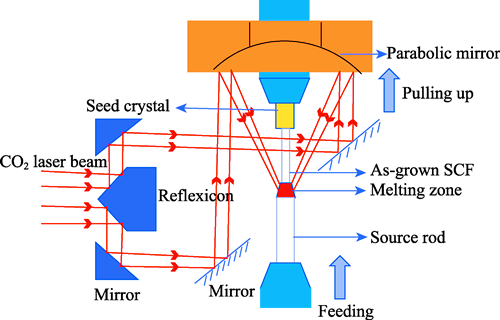
|
|
|
Tuning Nitrogen Species and Content in Carbon Materials through Constructing Variable Structures for Supercapacitors
SUN Peng, ZHANG Shaoning, BI Hui, DONG Wujie, HUANG Fuqiang
2021 Vol. 36 (7): 766–772
 Abstract
Abstract(
522 )
 HTML
HTML(
18)
 PDF
PDF(1965KB)(
1454
)
Carbon materials are favorable for supercapacitors but suffer from insufficient capacitance. Heteroatom doping, especially nitrogen (N) doping, is an effective method to significantly improve the electrochemical performance, but it is still a big challenge to achieve high active nitrogen content in carbon materials. This work successfully tuned nitrogen species and content by interaction between Si-O-Si network and aluminum oxide. Besides, the structure of carbon materials varies from a coral-like network to three-dimensional structure by adjusting the precursor composition. Oxygen (O) in oxides bonds with N in carbon materials during the reaction, which makes it difficult to escape, achieving high nitrogen content of 5.29at% at 1000 ℃. On the other hand, the interaction empowers the carbon material with large pore volume of ~1.78 cm3·g-1 and broad pore size distribution of 0.5-60 nm. Thus, the N-rich carbon material harvests high capacitance of 302 F·g-1 at 1 A·g-1 and excellent rate capability of 177 F·g-1@120 A·g-1. This unique nitrogen fixation method is a promising strategy for preparing high performance electrode materials of supercapacitors.
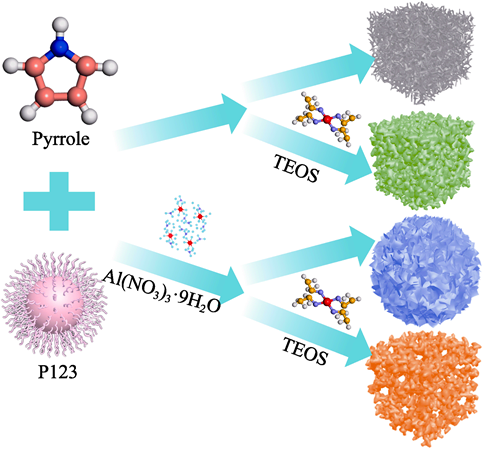
|
|
|
Molten Salt Synthesis of Nanolaminated Sc2SnC MAX Phase
LI Youbing, QIN Yanqing, CHEN Ke, CHEN Lu, ZHANG Xiao, DING Haoming, LI Mian, ZHANG Yiming, DU Shiyu, CHAI Zhifang, HUANG Qing
2021 Vol. 36 (7): 773–778
 Abstract
Abstract(
740 )
 HTML
HTML(
36)
 PDF
PDF(1180KB)(
959
)
The MAX phases are a family of ternary layered material with both metal and ceramic properties, and it is also precursor materials for synthesis of two-dimensional MXenes. The theory predicts that there are more than 600 kinds of stable ternary layered MAX phase materials. Now, more than 80 kinds of ternary layered MAX phases that the M-site elements are mainly from early transition metal have been experimental synthesized, but few researches are reported on MAX phases where M is a rare earth element. In this study, Sc, Sn and C powders were used as raw materials to synthesize a novel ternary Sc2SnC MAX phase via molten salt method. Phase composition and microstructure of Sc2SnC were confirmed by X-ray diffraction, scanning electron microscope and X-ray energy spectrum analysis. And, structural stability, lattice parameters, mechanical and electronic properties of Sc2SnC were investigated via density functional theory. The theoretical results show that Sc2SnC is thermodynamically stable, and the Sc2SnC is metallic in nature where the contribution from Sc-3d states dominates the electronic conductivity at the Fermi level. This study provides a route to explore more unknown ternary layered rare earth compounds Ren+1SnCn (Re=Sc, Y, La-Nd, n=1) and corresponding rare earth MXenes.
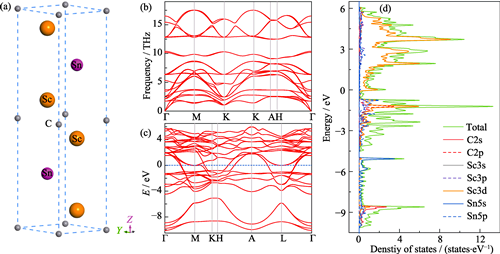
|
|
|
Electronic Property of PdSe2 Thin Films Fabricated by Post-selenization of Pd Films
WANG Hui, ZHANG Shujuan, CHEN Tingwei, ZHANG Chuanlin, LUO Haosu, ZHENG Renkui
2021 Vol. 36 (7): 779–784
 Abstract
Abstract(
599 )
 HTML
HTML(
22)
 PDF
PDF(2250KB)(
748
)
At present, the approaches to fabricate PdSe2 thin films mainly focus on mechanical exfoliation and chemical vapor deposition. In this study, we report a simple and efficient method to fabricate PdSe2 thin films on SiO2/Si substrates. Firstly, a Pd metal layer was deposited on a SiO2/Si substrate using magnetron sputtering. Then the PdSe2 thin film was obtained through selenization of the Pd layer at certain temperatures in a vacuum quartz ampule containing Se powder. According to the cross-sectional high-resolution transmission electron microscopy (HRTEM) image, the as-grown PdSe2 thin film has an average thickness of about 30 nm. The correlation between selenization temperature and electronic transport properties of PdSe2 thin films was investigated. PdSe2 thin films with a hole carrier concentration of ~1018 cm-3 and a mobility of ~48.5 cm2·V-1·s-1 are realized at a low selenization temperature of 300 ℃. It is worth noting that the mobility obtained by the vacuum selenization is superior to that of the p-type PdSe2 thin films fabricated by mechanical exfoliation from bulk PdSe2 single crystals. In addition, a relatively large room-temperature magnetoresistance (MR) of 12% is achieved for the PdSe2 thin films selenized at 300 ℃. With the increase in the selenization temperature from 300 ℃, mobility and magnetoresistance decrease due to the evaporation of Se element at high temperatures. This work demonstrates that present one-step selenization process is a facile and efficient approach to synthesize PdSe2 films, which could actually be used to prepare PdSe2 films in a large scale and may have potential applications for next-generation electronic and magneto-electronic devices.
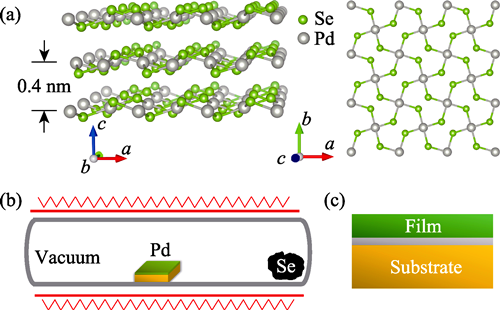
|
|